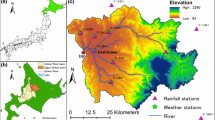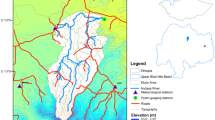Abstract
Based on the Regional Integrated Environmental Model System (RIEMS 2.0) developed by START TEA-COM RRC and Department of Atmospheric Science of Nanjing University, a dataset of observation and remote sensing over the Heihe River Basin (HRB) was used to recalibrate the model’s parameters, including topography elevation, land cover type, saturated soil water potential, saturated soil hydraulic conductivity, field moisture capacity, wilting point moisture, soil porosity, and parameter b of soil hydraulic conductivity, to build a high-resolution regional climate model for the HRB. Continuous simulation for the period from January 1 to December 31, 2000 was conducted using the regional climate model, with NCEP-FNL reanalysis data as the driving fields. The study focused on the ability of the model to simulate precipitation in the HRB. The analysis results showed the following: (1) For precipitation, the model could reproduce well the spatial pattern and seasonal cycle in different regions of the HRB, simulated precipitation was overestimated in the upper reaches of the HRB and underestimated in the lower reaches of the HRB, and seasonal precipitation biases were mostly in the range of −39.9%–9.6% of observations, which is mostly consistent with the IPCC report (2001). (2) The model could reproduce reasonably temporal evolution of pentad precipitation in different regions. Correlation coefficients between the simulated and observed pentad precipitation were 0.8123, 0.5064, and 0.7033 in the upper, middle, and lower reaches of the HRB, respectively. They reached a significance level of 1%. (3) Dynamical downscaling of a high-resolution regional climate model was used to overcome the deficiency of long-term, high-temporal/spatial-resolution meteorological dataset in the HRB, and to drive directly the integrated model that coupled ecological-hydrological and socioeconomic processes in the HRB.
Similar content being viewed by others
References
Cheng G D, Xiao H L, Xu Z M, et al. Water issue and its countermeasure in the inland river basin of Northwest China (in Chinese). J Glaciol Geocryol, 2006, 28: 406–413
Gao Y H, Cheng G D. Several points on mass and energy interaction between land surface and atmosphere in the Heihe River Basin (in Chinese). Adv Earth Sci, 2008, 23: 779–784
Gao Y H, Cheng G D, Li X, et al. Comparison of atmospheric data scaling transfer scheme in Heihe River Basin (in Chinese). Plateau Meteorol, 2005, 24: 563–569
Liu J M, Pei T F. Research progress on hydrological scaling (in Chinese). Chin J Appl Ecol, 2003, 14: 2305–2310
Yin X R, Xia J, Zhang X, et al. Recent progress and prospect of the study on uncertainties in hydrological modeling and forecasting (in Chinese). J Hydropower, 32: 27–31
Wilby R L, Wigley T M L. Downscaling general circulation model output: A review of methods and limitations. Prog Phys Geog, 1997, 21: 530–548
Salathe E P. Comparison of various precipitation downscaling methods for the simulation of streamflow in a rainshadow river basin. Int J Climatol, 2003, 23: 887–901
Benestad R, Chen D. The use of a calculus-based cyclone identification method for generating storm statistics. Tellus A, 2006, 58: 473–486
Yu E T, Wang H J, Sun J Q. A quick report on a dynamical downscaling simulation over China using the nested model. Atmos Ocean Sci Lett, 2010, 3: 325–329
Yu E T. High-resolution seasonal snowfall simulation over Northeast China. Chin Sci Bull, 2013, 58: 1412–1319
Gao Y H, Cheng G D, Cui W R, et al. Coupling of enhanced land surface hydrology with atmospheric mesoscale model and its implement in the Heihe River Basin (in Chinese). Adv Earth Sci, 2006, 21: 1283–1292
Gao Y H, Cheng G D, Liu W. Setup and validation of the soil texture type distribution data in the Heihe River Basin (in Chinese). Plateau Meteorol, 2007, 26: 958–966
Liu W, Cheng G D, Li H Y, et al. Landuse pattern of Heihe River Basin and its impact modeling (in Chinese). Plateau Meteorol, 2007, 26: 278–285
Liu S H, Jiang H Y, Hu F, et al. A study of surface energy fluxes in Heihe region simulated with a mesosca1e atmospheric model (in Chinese). Chin J Atmos Sci, 2008, 32: 1392–1400
Pan X D, Li X, Ran Y H, et al. Impact of underlying surface information on WRF modeling in Heihe River Basin (in Chinese). Plateau Meteorol, 2012, 31: 657–667
Pan X D, Li X. Validation of WRF Model on simulating forcing data for the Heihe River Basin. Sci Cold Arid Reg, 2011, 3: 344–357
Lakhtakia M N, Yarnal B, Johnson D L, et al. A simulation of river-basin response to mesoscale meteorological forcing: The Subsequenhanna River Basin Experiment (SRBEX). JAWRA, 1998, 43: 921–937
Leung L R, Wigmosta M S, Ghan S J, et al. Application of a subgrid orographic precipitation/surface hydrology scheme to a mountain watershed. J Geophys Res, 1996, 101: 12803–12817
Biljana M, Daniel C. Evaluation of the Hydrological cycle over the Mississippi River Basin as simulated by the Canadian regional climate model. J Hydromet, 2007, 8: 969–988
Takle E S, Roads J, Rockel B, et al. Transferability intercomparsion: An opportunity for new insight on the global water cycle and energy budget. Bull Amer Meteorol Soc, 2007, 88: 375–384
Xiong Z, Fu C B, Yan X D. Regional integrated environmental model system and its simulation of East Asia summer monsoon. Chin Sci Bull, 2009, 54: 4253–4261
Zhao D M, Fu C B, Yan X D. Testing the ability of RIEMS2.0 to simulate multi-year precipitation and air temperature in China. Chin Sci Bull, 2009, 54: 3101–3111
Dickinson R E, Henderson-Sellers. A Biosphere-Atmosphere Transfer Scheme (BATS) Version as coupled to the NCAR Community Climate Model, NCAR Technical Report, NCAR/TN-387+STR, 1993
Grell G. Prognostic evaluation of assumptions used by cumulus parameterizations. Mon Weather Rev, 1993, 121: 764–787
Fritsch J M, Chappell C F. Numberical prediction of convectively driven mesoscale pressure system. Part I: Convective parameterization. J Atmos Sci, 1980, 37: 1722–1733
Kiehl J T, Hack J J, Bonan G B, et al. Description of the NCAR community climate model (CCM3), Technical Report, NCAR/TN-420+STR, National Center for Atmospheric Research. 1996
Cosby B J, Hornberger G M, Clapp R B, et al. A statistical exploration of the relationships of soil moisture characteristics to the physical properties of soils. Water Resour Res, 1984, 20: 682–690
Wetzel P, Chang J T. Concerning the relationship between evapotranspiration and soil moisture. J Clim Appl Meteorol, 1987, 26: 18–27
Hillel D. Applications of Soil Physics. London: Academic Press, 1980
Kalnay E, Kanamitsu M, Kistler R, et al. The NCEP/NCAR 40-year reanalysis project. Bull Amer Meteorol Soc, 1996, 76: 437–472
Wu Y Q, Zhang Y H, Wen X H, et al. Hydrologic Cycle and Water Resource Modeling for the Heihe River Basin in Northwestern China (in Chinese). Beijing: Science Press, 2010
Ding Y J, Ye B S, Zhou W J. Temporal and spatial precipitation distribution in the Heihe catchment, Northwest China, during the past 40 a (in Chinese). J Glaciol Geocryol, 1999, 21: 42–48
Ding R, Wang F C, Wang J, et al. Analysis on spatial-temporal characteristics of precipitation in heihe river basin and forecast evaluation in recent 47 years (in Chinese). J Des Res, 2009, 29: 335–341
Zhang J, Li D L. Analysis on distribution character of rainfall over the Qilian Mountain and Heihe River valley (in Chinese). Plateau Meteorol, 2004, 23: 81–88
Liu Y, Zou S B. A study on the distributing climatic models in arid mountainous area—distributing temperature and precipitation models in high spatial resolution in the Qilian Mountain (in Chinese). J Lanzhou Univ Nat, 2006, 42: 7–12
Sun J, Jiang H, Wang K L, et al. The fine spatial distribution of mean precipitation and the estimation of total precipitation in the Heihe River Basin (in Chinese). J Glaciol Geocryol, 2011, 33: 318–324
Li Z Y, Yang J C, Li R Q, et al. The climatic analysis on weather modification in mid-section of Qilian Mountain and available weather patterns (in Chinese). Arid Meteorol, 2006, 24: 23–27
Cheng G D. Heihe River Basin Water-Ecological-Economic System Integrated Management (in Chinese). Beijing: Science Press, 2009
Houghton J, Ding Y H, Griggs D G, et al. Climate Change: The Scientific Basis. Cambridge: Cambridge University Press, 2001
Zhang L J, Zhao W Z, He Z B, et al. The characteristics of precipitation and its effects on runoff in a small typical catchment of Qilian Mountain (in Chinese). J Glaciol Geocryol, 2008, 30: 776–782
Author information
Authors and Affiliations
Corresponding author
Additional information
This article is published with open access at Springerlink.com
About this article
Cite this article
Xiong, Z., Yan, X. Building a high-resolution regional climate model for the Heihe River Basin and simulating precipitation over this region. Chin. Sci. Bull. 58, 4670–4678 (2013). https://doi.org/10.1007/s11434-013-5971-3
Received:
Accepted:
Published:
Issue Date:
DOI: https://doi.org/10.1007/s11434-013-5971-3




